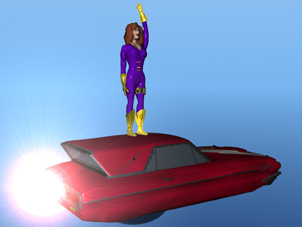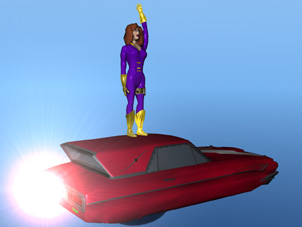|
|
|
GALLERY CONTINUED
PAGE SEVENTEEN


The character above is based on the Hurricane Entertainment Comic book character "Chassis McBain" (all rights reserved http://www.hurricanec.com/ ) from the fertile imagination of Bill O'Neill. The "maglev" hovering rocket car is from his design too, which turned out to drag and magnet pretty quickly from our friend the '64 Thunderbird included in the INSPIRE3D Objects repertoire. The most recent version of this character (after two years) may be found here.
If you have been browsing these pages with an eye to learn or purchase the program, let me share this observation. You don't need to know a lot to do a lot. In the pencil and rowing animation projects on other Gallery pages, "shadow map" lighting, hinging and some point-dragging produced some very professional- looking results. Sublime!
One of the differences between one artist and another will be the willingness to bend one's vision to fit the available materials and one's skill level with them. One of life's mysteries I suppose is how a sculptor makes the most of what is available to them, either striving for what seems the most coherent presentation of content or fitting the content to the available form.
Spiritually, I have found some of my greatest work has come from camera "tests," seeing whether or not the product provided was up to what I needed to do. From a Golden-Ruley perspective, I was pitting my humble ambitions against the hundreds involved in creating something beautiful like a fine camera or program. "Are your results worthy of my input?" and "Let's see what you have for me."
Also, I have been venturing into nostril-land.
I was on a pretty skimpy budget when I began trying to polish my chops in order to pay off my defaulted student loan, and I didn't buy any of the books that other artists were buying in order to nail facial details. I sort of suspected that people with more money were making faces with realistic nostrils but I made do with a very steep learning curve.
Are you having trouble really understanding nostrils? Go ahead and e-mail me: scotttygett@juno.com . I wish this kind of confusion on nobody. The number one problem with noses is that they need to have many more polygons than the novice will think to include. There may need to be extra polygons holding the shape of the nose-holes. The noses will need to be a dozen polygons across. Sadly, there are some "free" objects circulating which have insufficient polygons, and which do not "morph" very acceptably as a result. It would not occur to me to think the fault was with the model. Now we both know.
All contents copyrighted Scott Lee Tygett c. 2000
< BACK . . . . . . . . . . . . . . < HOME > . . . . . . . . . . . . . . NEXT >